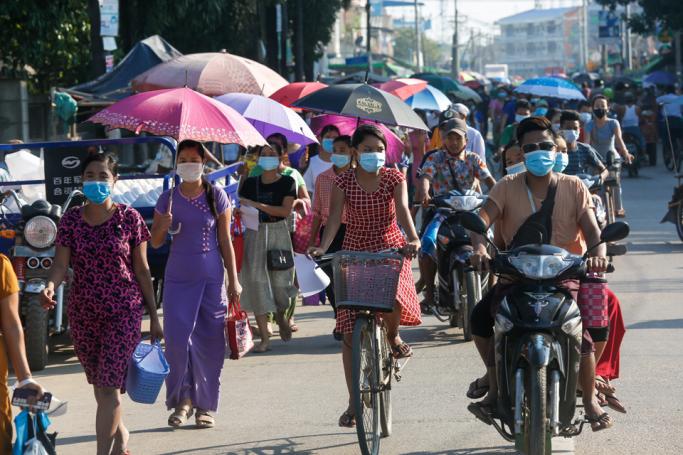Myanmar is entering the rainy season from early June and the second phase of the COVID-19 outbreak. When people resume their lives, out of economic necessity, practicing physical distancing will be more important than ever. As this concept is not practiced widely by the population and not well understood, raising public health literacy and public awareness are needed.
It has been hectic days for the two and half months, after the first COVID-19 positive case in Myanmar was identified on March 23. A broad spectrum of public health and other socio-economic measures was undertaken by the Government to curb the spread of the virus. Thingyan water festival event and many religious activities were cancelled and a stay at home period announced, curfews were ordered, domestic and international travel restricted, and some of the Yangon townships with a spike in COVID-19 cases were locked down. This was needed as the public health system of Myanmar has limited capacity to deal with large-scale outbreak.
By the end of May, the number of new cases had dwindled to none or only a few per day. On May 30, the Ministry of Health issued an order that boiled down to a softening of some of the measures taken and in which it also stated that community spread is not a factor at this point in time, and that most new cases are imported from abroad. On June 15, when the current measures lapse, it is to be expected that a further softening of restrictions will be announced. The Ministry of Education has announced that basic education high schools will be opened by July 1st. There is also some relaxation by reopening the Food and Beverage Shops, and main markets.
Myanmar is not out of the woods, though. The monsoon season is the traditional influenza and dengue season, so we must remain vigilant. In addition to this, the economic impact of the COVID-19 measures has been sizeable, especially on the poor. Thousands of jobs have been lost, remittances of migrant workers have shrunk, and inward investment has come to a grinding halt. In short, the Government is facing a difficult balancing act: how public health would be protected when everybody wants to go back to work? There is also the political dimension, with the elections looming large and several parties jockeying for position or criticizing the Government.
It is unavoidable that Myanmar society will re-open. So, how can we keep ourselves safe in that scenario? That is the key question that the Post-COVID Advisory Committee, set up by the Minister of Health and Sports, Dr U Myint Htwe, and of which the authors are members, is currently pondering.
Of the protective behaviors that need to be maintained, mask wearing, temperature measuring and hand washing are already quite common and well understood among general population. Physical/social distancing is not nearly practiced as widely, particularly in low income neighbourhoods and rural environments.
One of the reasons for the lack of distancing can be found in part of Myanmar culture. It is considered to be slightly awkward to be far away from your relatives, friends or colleagues, and speak each other loudly. In situations where there is a clear difference of hierarchy, soft speaking is required. In ASEAN culture, the concept of private space is not as well developed as in East Asian or Western countries. People are used to getting close to each other. On top of that the term “social distancing” is considered to be confusing.
One of the challenges in urban and metro areas is that it is hard for low income workers to keep their distance. They rely on cheap public transport – trains and buses packed with people – and often work in crowded circumstances like markets/factories. The COVID-19 guidelines for management of the factory’s floor, which the Ministry of Health and Sports, had tried to address this issue. Nonetheless, for many factories, especially in the garment sector, it will be hard to achieve 100 % compliance.
In rural areas, the challenges are different. Farmers and farmhands work in open air circumstances, with a lot of ventilation and some distance between people. Their huts usually have windows, and thus, virus-carrying aerosols are dispersed rapidly by drafts. In the villages and hamlets of Myanmar gatherings like religious ceremonies, village meetings and marriage ceremonies pose the largest risk of infection. It’s important that rural audiences are reached with tailor-made messages about the risks they are facing and how they can protect themselves best against infection.
In the first phase of the COVID-19 outbreak in Myanmar, the People’s Health Foundation, in close collaboration with the Ministry of Health and Sports (MoHS), ran the mass media campaign “Let’s Beat COVID Together”, which was funded by Bloomberg Philanthropies. This campaign was obviously just one piece of the puzzle; the Ministry of Health and Sports has stepped up admirably and distributed a broad spectrum of materials on safe behavior, like wearing masks, stay at home, keep distance, etc., in the last two months.
During the early phase of the COVID-19-crisis, MoHS officials and staff responded quickly and worked tirelessly to stop the virus from spreading further. After this first period of stringent measures and broad messaging, we now need to focus on the behaviors that will keep people safe when they go back to work and resume their normal lives. Keeping a safe distance is going to be crucial to curb the spread of the virus in the monsoon season. Clear and persuasive messaging through public awareness campaigns, tailored to urban and rural audiences, will be the key in the coming months.
Only then can we be confident that we can prevent the second wave of infections that some fear.
Dr U Than Sein is the President of the People’s Health Foundation. Dr U Thein Shwe is the Vice-President. They both are members of the Post-COVID-19 Advisory Committee of the Ministry of Health and Sports.












